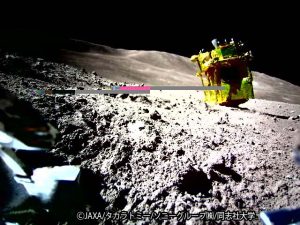Landing on the moon is no easy feat. The success of Japan’s first lunar probe has been fraught with tension. The unmanned rover, known as Smart Lander for Investigating Moon (SLIM), landed upside down on the surface of the moon and lost power supply as a result. However, the Japan Aerospace Exploration Agency (JAXA) has now confirmed that SLIM is functioning again, reigniting the mission to discover the origin of the moon. The cameras have started taking photos again and JAXA believes the solar panels have also begun working.
Japan’s mission to explore the moon has been more than two decades in the making. It aims to search for a mineral called olivine and compare it with the same mineral on Earth. But the highly anticipated project has not been smooth sailing. Just 50 meters above the lunar surface, one of the two engines lost power, reducing thrust by half. JAXA project manager Sakai Shinichiro praised the team for managing to land the spacecraft with only one engine. In fact, JAXA says it broke the world record for its unusually accurate landing, with an error margin of just 55 meters from the target site.
Yet the uneven engine thrust at the crucial landing stage caused SLIM to touch down upside down when it reached the lunar surface on January 19. Sakai said JAXA is investigating the cause of the engine problem.
The initial euphoria over SLIM’s soft-landing on the moon lasted several hours, after which the spacecraft failed to switch from battery to solar power.
Footage taken from two small robots released before landing showed the solar panels in an awkward position, facing away from the intended direction – and the sun. The spacecraft had several hours of battery powered electricity on board, but it was switched off with 12 percent remaining in the hopes that it could resume its mission. JAXA pinned its hopes on the solar panels kicking in when the sunlight changed direction.
Until January 28, SLIM was sitting dormant on the Moon. On that day, over a week after the landing, JAXA’s hopes came true, as sunlight reached the solar power cells, causing the probe to start up and automatically resume operations.
The team will have to act fast to collect data as the probe will only have a few days before the temperature on the moon’s surface rises to a blistering 250 degrees Fahrenheit and eventually destroys the spacecraft.
The European Union’s Space Agency also faced a similar setback in 2014 when its spacecraft landed on a cliff on a comet and was unable to tap into its solar panels. Fortunately, when the comet approached the sun, solar power capacity was restored. SLIM was designed with this precedent in mind. But there are concerns that SLIM’s solar panels may have been damaged during landing.
SLIM is the product of high-tech collaborations with Mitsubishi, Ritsumeikan University’s Space and Earth Exploration Research Center, the tech-focused University of Aizu, as well as Japanese toy company Takara Tomy. JAXA says the pinpoint landing is a significant technological leap in lunar exploration and was made possible by two robots on SLIM being fitted with newly developed camera and image sensors, which performed automated image-based navigation without help from humans. JAXA says Japan has a competitive advantage in pinpoint landing, which will be a necessary technique in any lunar mission hereafter.
Japan has been largely absent from the international race to explore the moon. It has now become the fifth country to land a spacecraft on the moon following after the United States, Russia, China, and India. Japan’s government-funded lunar exploration is facing fierce competition from private venture firm iSpace, which attempted to land on the moon unsuccessfully last year.

































